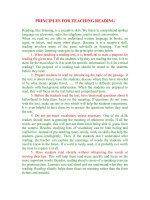Costing principles
Bạn đang xem bản rút gọn của tài liệu. Xem và tải ngay bản đầy đủ của tài liệu tại đây (465.47 KB, 49 trang )
Costing Principles
1
Cost and management
accounting
Provides management with costs for
products, inventories, operations or
functions and compares actual to
predetermined data
It also provides a variety of data for
many day-to-day decision as well as
essential information for long-range
decisions
2
Functions of managerial
accounting
Determining the cost
Providing relevant information for better
decision-making
Providing information for planning,
control, decision-making and
application
3
Planning
Deals with the estimation of product
costs, setting up of costing system to
record cost data, preparation of cost
standards and budgets, planning of
materials and manpower resources,
analysing cost behavior with changes in
levels of activity
4
Control
Deals with the maintenance of product
costing record, comparison of actual
performance with standards or budgets,
anlaysis of variances, recommendation
of corrective actions, controlling cost to
ensure operational efficiency and
effectiveness
5
Decision-making
Deals with whether it is more profitable
to make or buy a component,
determine the economic order quantity
and production batch size, replace fixed
asset, add or drop products, decide
pricing
6
Application
Cost accounting has extended from
manufacturing operations to a variety
of service industries such as hotels,
bands, airline, etc
Cost accounting system should be
flexible and adaptable to meet the new
business environment and the changing
nature of the company
7
Element of cost
Cost object
Cost
Cost unit
Cost centre
Profit centre
8
Cost object
It is an activity or item or operation for
which a separate measurement of costs
is desired
E.g. the cost of operating the personnel
department of a company, the cost of a
repair fob, and the cost for control
9
Cost
It is the amount of expenditure incurred
on a specific cost object
Total cost = quantity used * cost per
unit (unit cost)
10
Cost unit
It is a quantitative unit of product or
service in which costs are ascertained,
e.g. cost per table made, cost per
metre of cloth
11
Cost centre
It is a location or function of an
organisation in respect of which costs
are ascertained
E.g. the rent, rates and maintenance of
buildings; the wages and salaries of
strorekeepers
12
Profit centre
It is location or function where
managers are accountable for sales
revenues and expenses
E.g. division of a company that is
responsible for the sales of products
13
Cost classification
Direct cost
Indirect cost (overhead)
14
Direct cost
Cost that can be identified specifically
with or traced to a given cost object
The direct costs consist of the following
three elements:
Direct materials
Direct labour
Direct expenses
15
Direct materials
The cost of materials – the cost of
materials used entering into and
becoming the elements of a product or
service
E.g. fabrics in garments
16
Direct labour
The cost of remuneration for working
time
E.g. assembly workers’ wages in toy
assembly
17
Direct expenses
Other costs which are incurred for a
specific product or service
E.g. royalties
18
Indirect cost (overhead)
Cost that cannot be identified
specifically with or traced to a given
cost object
They are identified with cost centres as
overheads
Indirect materials
Indirect labour
Indirect expenses
19
Indirect materials
Such as stationery, consumable
supplies, spare parts for machine that
assist to the production of final
products
20
Indirect labour
Such as salaries of factory supervision
and office staff that do not directly
involve in production of the final
product
21
Indirect expenses
Such as rent, rates, depreciation,
maintenance expenses that do not have
instant relationships with the
manufacturing processes
22
Cost accumulation
•Prime cost = direct materials + direct labour + direct expenses
•Production cost = Prime cost + factory overhead
OR
= Direct materials + Conversion cost
*Conversion cost is the production cost of converting raw materials into
finished product
•Total cost = Prime cost + Overheads (admin, selling,distribution cost)
OR
= Production cost + period cost (administrative, selling,
distribution and finance cost)
•Period cost is treated as expenses and matched against sales for calculating
profit, e.g. office rental
23
Cost coding
A code is a system of symbols designed
to be applied to a classified set of items
to give a brief, accurate reference,
facilitating entry, collation and analysis
Coding is important in modern
computerised accounting systems for
catergories various composite
accounting items
24
Reasons
To reducing error owing to descriptions
Enable easy recalling
Reduce computer file size as a code
25









